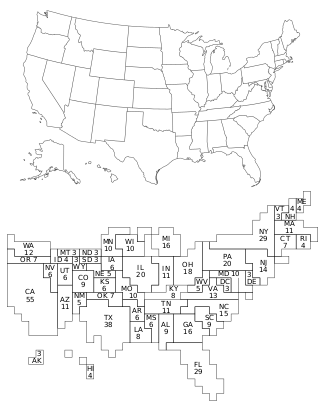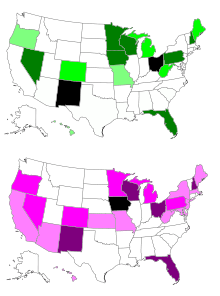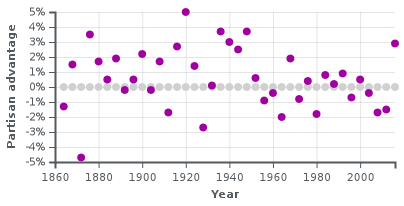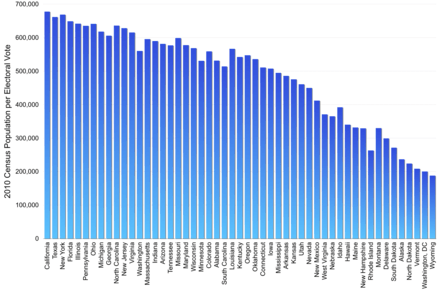National Popular Vote Interstate Compact
The National Popular Vote Interstate Compact (NPVIC) is an agreement among a group of U.S. states and the District of Columbia to award all their electoral votes to whichever presidential candidate wins the overall popular vote in the 50 states and the District of Columbia. The compact is designed to ensure that the candidate who receives the most votes nationwide is elected president, and it would come into effect only when it would guarantee that outcome.[3][4] As of March 2020, it has been adopted by fifteen states and the District of Columbia, although it is suspended in Colorado.[2] Together, they have 196 electoral votes counting Colorado, which is 36% of the Electoral College and 73% of the 270 votes needed to give the compact legal force. Certain legal questions, however, may affect implementation of the compact.
Status as of March 2020:
                             0
270
538
Each square in the cartogram represents one electoral vote.
* Colorado's membership is suspended pending the outcome of a statewide referendum.[2] | |
| Drafted | January 2006 |
|---|---|
| Effective | Not in effect |
| Condition | Adoption by states (including the District of Columbia) whose collective electoral votes represent a majority in the Electoral College. Note: The agreement would be in effect only among the assenting political entities. |
| Signatories |
|
Mechanism
Proposed in the form of an interstate compact, the agreement would go into effect among the participating states in the compact only after they collectively represent an absolute majority of votes (currently at least 270) in the Electoral College. In the next presidential election after adoption by the requisite number of states, the participating states would award all of their electoral votes to the candidate with the largest national popular vote total across the 50 states and the District of Columbia. As a result, that candidate would win the presidency by securing a majority of votes in the Electoral College. Until the compact's conditions are met, all states award electoral votes in their current manner.
The compact would modify the way participating states implement Article II, Section 1, Clause 2 of the U.S. Constitution, which requires each state legislature to define a method to appoint its electors to vote in the Electoral College. The Constitution does not mandate any particular legislative scheme for selecting electors, and instead vests state legislatures with the exclusive power to choose how to allocate their states' electors (although systems that violate the 14th Amendment, which mandates equal protection of law and prohibits racial discrimination, would be prohibited).[4][5] States have chosen various methods of allocation over the years, with regular changes in the nation's early decades. Today, all but two states (Maine and Nebraska) award all their electoral votes to the single candidate with the most votes statewide (the so-called "winner-take-all" system). Maine and Nebraska currently award one electoral vote to the winner in each congressional district, and their remaining two electoral votes to the state-wide winner.
Motivation
| Election | Electoral College Winner | Popular winner | Difference | Turnout[6] | |||||
|---|---|---|---|---|---|---|---|---|---|
| 1824 | Adams | 30.9% | 113,122 | Jackson | 41.4% | 157,271 | 10.5% | 44,149 | 26.9% |
| 1876 | Hayes | 47.9% | 4,034,311 | Tilden | 50.9% | 4,288,546 | 3.0% | 254,235 | 82.6% |
| 1888 | Harrison | 47.8% | 5,443,892 | Cleveland | 48.6% | 5,534,488 | 0.8% | 90,596 | 80.5% |
| 2000 | Bush | 47.9% | 50,456,002 | Gore | 48.4% | 50,999,897 | 0.5% | 543,895 | 54.2% |
| 2016 | Trump | 46.1% | 62,984,828 | Clinton | 48.2% | 65,853,514 | 2.1% | 2,868,686 | 60.1% |
Reasons given for the compact include:
- The current Electoral College system allows a candidate to win the Presidency while losing the popular vote, as happened in the elections of 1824, 1876, 1888, 2000, and 2016.[7] (The 1960 election is also a disputed example.[8]) In the 2000 election, for instance, Al Gore won 543,895 more votes nationally than George W. Bush, but Bush secured 5 more electors than Gore, in part due to a narrow Bush victory in Florida; in the 2016 election, Hillary Clinton won 2,868,691 more votes nationally than Donald Trump, but Trump secured 77 more electors than Clinton, in part due to narrow Trump victories in Michigan, Pennsylvania, and Wisconsin (a cumulative 77,744 votes).
- State winner-take-all laws encourage candidates to focus disproportionately on a limited set of swing states (and in the case of Maine and Nebraska, swing districts), as small changes in the popular vote in those areas produce large changes in the electoral college vote. For example, in the 2016 election, a shift of 2,736 votes (or less than 0.4% of all votes cast) toward Donald Trump in New Hampshire would have produced a 4 electoral vote gain for his campaign. A similar shift in any other state would have produced no change in the electoral vote, thus encouraging the campaign to focus on New Hampshire above other states. A study by FairVote reported that the 2004 candidates devoted three quarters of their peak season campaign resources to just five states, while the other 45 states received very little attention. The report also stated that 18 states received no candidate visits and no TV advertising.[9] This means that swing state issues receive more attention, while issues important to other states are largely ignored.[10][11][12]
- State winner-take-all laws tend to decrease voter turnout in states without close races. Voters living outside the swing states have a greater certainty of which candidate is likely to win their state. This knowledge of the probable outcome decreases their incentive to vote.[10][12] A report by the Committee for the Study of the American Electorate found that 2004 voter turnout in competitive swing states grew by 6.3% from the previous presidential election, compared to an increase of only 3.8% in noncompetitive states.[13] A report by The Center for Information and Research on Civic Learning and Engagement (CIRCLE) found that turnout among eligible voters under age 30 was 64.4% in the ten closest battleground states and only 47.6% in the rest of the country – a 17% gap.[14]
Debate
The project has been supported by editorials in newspapers, including The New York Times,[10] the Chicago Sun-Times, the Los Angeles Times,[15] The Boston Globe,[16] and the Minneapolis Star Tribune,[17] arguing that the existing system discourages voter turnout and leaves emphasis on only a few states and a few issues, while a popular election would equalize voting power. Others have argued against it, including the Honolulu Star-Bulletin.[18] An article by Pete du Pont, a former Governor of Delaware, in the opinion section of The Wall Street Journal[19] has called the project an urban power grab that would shift politics entirely to urban issues in high population states and allow lower caliber candidates to run. A collection of readings pro and con has been assembled by the League of Women Voters.[20]
Some of the major points of debate are detailed below:
Protective function of Electoral College
Opponents of a national popular vote contend that the Electoral College serves to protect the country from the election of a person who is unfit to be president. Certain founders conceived of the Electoral College as a deliberative body which would weigh the inputs of the states, but not be bound by them, in selecting the president.[21] However, the Electoral College has never served such a role in practice. From 1796 onward, presidential electors have acted as "rubber stamps" for their parties' nominees. As of 2016, no election outcome has been determined by an elector deviating from the will of their state,[22] and thirty-two states and the District of Columbia have laws to prevent such "faithless electors",[23][24] though cases regarding the constitutionality of such laws are currently pending before the Supreme Court.[25] Moreover, the National Popular Interstate Compact does not eliminate the Electoral College or affect faithless elector laws; it merely changes the way in which electors are pledged by the participating states.
Campaign focus
Spending on advertising per capita:
Campaign visits per 1 million residents:
|
 |
Under the current system, campaign focus – in terms of spending, visits, and attention paid to regional or state issues – is largely limited to the few swing states whose electoral outcomes are competitive, with politically "solid" states mostly ignored by the campaigns. The adjacent maps illustrate the amount spent on advertising and the number of visits to each state, relative to population, by the two major-party candidates in the last stretch of the 2004 presidential campaign. Supporters of the compact contend that a national popular vote would encourage candidates to campaign with equal effort for votes in competitive and non-competitive states alike.[27] Critics of the compact argue that candidates would have less incentive to focus on states with smaller populations or fewer urban areas, and would thus be less motivated to address rural issues.[19][28]
Disputed results and electoral fraud
Opponents of the compact have raised concerns about the handling of close or disputed outcomes. National Popular Vote contends that the election being decided on the basis of a disputed tally is far less likely under the NPVIC, which creates one large nationwide pool of voters, than under the current system, in which the national winner may be determined by an extremely small margin in any one of the fifty-one smaller statewide tallies.[28] However, it is possible for the national popular vote to be closer than the vote tally within any one state. In the event of an exact tie in the nationwide tally, NPVIC member states will award their electors to the winner of the popular vote in their state.[29] Under the NPVIC, each state will continue to handle disputes and statewide recounts as governed by their own laws.[30] The NPVIC does not include any provision for a nationwide recount, though Congress has the authority to create such a provision.[31]
Pete du Pont argues that, in 2000, "Mr. Gore's 540,000-vote margin amounted to 3.1 votes in each of the country's 175,000 precincts. 'Finding' three votes per precinct in urban areas is not a difficult thing...".[19] However, National Popular Vote contends that electoral fraud affecting the outcome would be more difficult to achieve under a national popular vote than under the current system, because of the greater number of votes that would likely need to be shifted – under the current system, a close election may be determined by the outcome in just one "tipping point" state, the margin of which is likely to be far smaller than the nationwide margin. This is due to the smaller pool of voters at the state level, and the fact that several states may have close results.[28]
Suggested partisan advantage

Some supporters and opponents of the NPVIC believe it gives one party an advantage relative to the current Electoral College system. Former Delaware Governor Pete du Pont, a Republican, has argued that the compact would be an "urban power grab" and benefit Democrats.[19] However, Saul Anuzis, former chairman of the Michigan Republican Party, wrote that Republicans "need" the compact, citing what he believes to be the center-right nature of the American electorate.[33]
A statistical analysis by FiveThirtyEight's Nate Silver of all presidential elections from 1864 to 2016 (see adjacent chart) found that the Electoral College has not consistently favored one major party or the other, and that any advantage in the Electoral College does not tend to last long, noting that "there's almost no correlation between which party has the Electoral College advantage in one election and which has it four years later."[32] Although in all four elections since 1876 in which the winner lost the popular vote, the Republican became president, Silver's analysis shows that such splits are about equally likely to favor either major party.[32] A popular vote-Electoral College split favoring the Democrat John Kerry nearly occurred in 2004.[34]
New Yorker essayist Hendrik Hertzberg also concluded that the NPVIC would benefit neither party, noting that historically both Republicans and Democrats have been successful in winning the popular vote in presidential elections.[35]
State power relative to population

There is some debate over whether the Electoral College favors small- or large-population states. Those who argue that the College favors low-population states point out that such states have proportionally more electoral votes relative to their populations.[note 1][18][36] In the least-populous states, with three electors, this results in voters having 143% greater voting power than they would under purely proportional allocation, while in the most populous state, California, voters' power is 16% smaller than under proportional allocation. The NPVIC would give equal weight to each voter's ballot, regardless of what state they live in.
Others, however, believe that since most states award electoral votes on a winner-takes-all system (the "unit rule"), the potential of populous states to shift greater numbers of electoral votes gives them more clout than would otherwise be expected.[37][38][39]
Opponents of a national popular vote contend that the Electoral College is a fundamental component of the federal system established by the Constitutional Convention. Specifically, the Connecticut Compromise established a bicameral legislature – with proportional representation of the states in the House of Representatives and equal representation of the states in the Senate – as a compromise between less populous states fearful of having their interests dominated and voices drowned out by larger states,[40] and larger states which viewed anything other than proportional representation as an affront to principles of democratic representation.[41] The Electoral College extends the Connecticut Compromise from the Legislative Branch to the Executive Branch by assigning each state a number of electoral votes equal to their representation in both the House of Representatives and the Senate. A national popular vote, opponents argue, would create an imbalance in the federal system by keeping the Connecticut Compromise for the Legislative Branch and removing it from the Executive Branch.
Negation of state-level majorities
Two governors who have vetoed NPVIC legislation, Arnold Schwarzenegger of California and Linda Lingle of Hawaii, both in 2007, objected to the compact on the grounds that it could require their states' electoral votes to be awarded to a candidate who did not win a majority in their state. (Both states have since enacted laws joining the compact.) Supporters of the compact counter that under a national popular vote system, state-level majorities are irrelevant; in any state, votes contribute to the nationwide tally, which determines the winner. The preferences of individual voters are thus paramount, while state-level majorities are an obsolete intermediary measure.[42][43][44]
Legality
Constitutionality
Compact Clause
The Compact Clause of Article I, Section X of the United States Constitution states that "No State shall, without the Consent of Congress ... enter into any Agreement or Compact with another State".[45] In a report released in October 2019, the Congressional Research Service (CRS) cited the U.S. Supreme Court's ruling in Virginia v. Tennessee (1893) – reaffirmed in U.S. Steel Corp. v. Multistate Tax Commission (1978) and Cuyler v. Adams (1981)[46] – as stating that the words "agreement" and "compact" are synonyms, and that explicit congressional consent of interstate compacts is not required for agreements "which the United States can have no possible objection or have any interest in interfering with".[47] However, the report asserted, the Court required explicit congressional consent for interstate compacts that are "directed to the formation of any combination tending to the increase of political power in the States, which may encroach upon or interfere with the just supremacy of the United States" — meaning where the vertical balance of power between the federal government and state governments is altered in favor of state governments.
The CRS report states that "Whether the NPV initiative requires congressional consent under the Compact Clause first requires a determination as to whether NPV even constitutes an interstate compact."[48] Yale Law School professor Akhil Amar, one of the compact's framers, has argued that because the NPVIC does not create a "new interstate governmental apparatus" and because "cooperating states acting together would be exercising no more power than they are entitled to wield individually", the NPVIC probably does not constitute an interstate compact and cannot contravene the Compact Clause.[49] Conversely, the CRS report cites the Court's opinion in Northeast Bancorp v. Federal Reserve Board of Governors (1985) as suggesting that a requirement of a new interstate governmental entity is a sufficient but not a necessary condition to qualify an agreement as being an interstate compact under the Compact Clause.[48] Instead, the CRS report cites the Court's opinions in Virginia v. Tennessee and Northeast Bancorp as stating that any agreement between two or more states that "cover[s] all stipulations affecting the conduct or claims of the parties", prohibits members from "modify[ing] or repeal[ing] [the agreement] unilaterally", and requires "'reciprocation' of mutual obligations" constitutes an interstate compact. Noting that the NPVIC meets all of those requirements, the CRS report concludes that "the initiative can be described as an interstate compact."[48]
As part of concerns about whether the NPVIC would shift power from the federal government to state governments, at least two legal scholars have suggested that the NPVIC would require explicit congressional approval because it would remove the possibility of contingent elections for President being conducted by the U.S. House of Representatives under the 12th Amendment.[50][51] The CRS report notes that only two presidential elections (1800 and 1824) have been determined by a contingent election, and whether the loss of such elections would be a de minimis diminishment of federal power is unresolved by the relevant case law. The report does reference U.S. Steel Corp. v. Multistate Tax Commission as stating that the "pertinent inquiry [with respect to the Compact Clause] is one of potential, rather than actual, impact on federal supremacy" in that the potential erosion of an enumerated power of the U.S. House of Representatives could arguably require congressional approval.[47] Proponents of the compact counter that if removing the possibility of contingent elections is grounds for unconstitutionality, then Congress setting the size of the House at an odd number, as it did in 1911 (resulting in an odd number of electors until 1961), was also unconstitutional.[52][53]
The CRS report goes on to cite the Supreme Court's rulings in Florida v. Georgia (1855) and in Texas v. New Mexico and Colorado (2018) as recognizing that explicit congressional consent is also required for interstate compacts that alter the horizontal balance of power amongst state governments.[48] University of Colorado Law School professor Jennifer S. Hendricks has argued that the NPVIC would not alter the power of non-compacting state governments because all state governments would retain their right to select the electors of their choosing.[54] Bloomberg Law editor Michael Brody has argued that "the role of electors has yet to be defined by a court," and cites the Supreme Court ruling in Ray v. Blair (1952) as suggesting that the 12th Amendment does not require that electors must vote for the candidate whom they are pledged to. Brody notes that because the NPVIC only binds state legislatures and not electors, those electors would retain independent withdrawal power as faithless electors at the request of the compacting states unless the compacting states adopt criminal penalties or other statutes that bind the electors – which 10 of the 15 current member states and the District of Columbia currently do, in addition to 19 other states.[55][56] On January 17, 2020, the Supreme Court agreed to hear the case Chiafalo v. Washington, which will determine whether criminal penalties for faithless electors violate the electors' 1st Amendment rights.
Other legal scholars have argued that the power of non-compacting states would be altered because, under the NPVIC, a state's power in determining the outcomes of presidential elections would be changed from the percentage of electors it has in the electoral college to the state's percentage of the popular vote, rendering the right of non-compacting state governments to appoint their own electors moot.[50][57][58][59] Additionally, Ian J. Drake, an associate professor of political science and law at Montclair State University, has argued that because Cuyler v. Adams held that congressional approval of interstate compacts makes them federal laws,[60] Congress cannot consent to the NPVIC without violating the Supremacy Clause, because under Article I, Section VIII, Congress has no enumerated or implied powers to alter the presidential election process except as part of the constitutional amendment process.[59][61] Labor lawyer Bradley T. Turflinger and the organizers of NPV Inc. dispute Drake's conclusion, and the NPV Inc. organizers have stated that they plan to seek congressional approval if the compact is approved by a sufficient number of states.[62][63] Citing Drake,[59] the CRS report concludes that if the NPVIC were to be enacted by the necessary number of states, it would likely become the source of considerable litigation, and it is likely that the Supreme Court will be involved in any resolution of the constitutional issues surrounding it.[48]
Plenary power doctrine
Proponents of the compact, such as law professors Akhil and Vikram Amar (the compact's original framers),[64] as well as U.S. Representative Jamie Raskin from Maryland's 8th congressional district (a former law professor),[65] have argued that state legislatures have the plenary power to appoint electors in accordance with the national popular vote under the Elections Clause of Article II, Section I,[66] which states that "Each State shall appoint, in such Manner as the Legislature thereof may direct, a Number of Electors, equal to the whole Number of Senators and Representatives to which the State may be entitled in the Congress".[45] Vikram Amar, along with other legal scholars, have also cited the Supreme Court's rulings in McPherson v. Blacker (1892) and Arizona State Legislature v. Arizona Independent Redistricting Commission (2015) as recognizing that states have wide discretion in selecting the method by which they appoint their electors.[67][68][69]
However, the CRS report cites the Supreme Court's opinion in McPherson v. Blacker as stating that state legislatures have "conceded plenary power ... in the matter of the appointment of electors," and citing the Court's opinions in Williams v. Rhodes (1968) and Oregon v. Mitchell (1970) that struck down state laws concerning the appointment of electors that violated the Equal Protection Clause of the 14th Amendment, the CRS report concludes that a state's power to select the method by which its electors are appointed is not absolute.[70] Robert Natelson, a senior fellow at the libertarian Independence Institute in constitutional jurisprudence and a member of the conservative American Legislative Exchange Council's board of scholars, has also argued that a state legislature's power to appoint its electors cannot be absolute because otherwise states would be permitted to appoint their electors in a manner that would violate public trust (e.g. by holding an auction to sell their electoral votes to the highest bidder).[51] Natelson has also argued that US states' power to select electors must also be compatible in a substantive sense with the general US constitutional scheme for US presidential elections that gives smaller US states disproportionate weight relative to their population in selecting the US President.[51] The NPVIC would allegedly be incompatible with this general US constitutional scheme as a substantive matter (as opposed to as a formal matter) because it would de facto eliminate the disproportionate weight that smaller US states have relative to their population in selecting the US President.[51]
Additionally, the CRS report notes that while the Court's opinion in McPherson v. Blacker emphasized that the variety of state laws that existed shortly after the ratification of the Constitution indicates that state legislatures have multiple alternative "modes of choosing the electors", the Court did not identify selecting electors in accordance with the results of the national popular vote as one of them. This is because, according to the CRS report, there appears to be no evidence contemporaneous with the ratification of the Constitution of a state selecting its electors in such a manner, and the CRS report cites the Court's opinion in U.S. Term Limits, Inc. v. Thornton (1995) as concluding that states cannot exercise their enumerated powers under Article I or Article II in a way that would "effect a fundamental change in the constitutional structure" (except as outlined in Article V as part of the constitutional amendment process),[70] a view at least three legal scholars have argued applies for the NPVIC.[61][71][51]
Voting Rights Act of 1965
A 2008 Columbia Law Review article by Columbia Law School student David Gringer suggested that the NPVIC could potentially violate Sections 2 and 5 of the Voting Rights Act of 1965 (VRA).[71] However, in 2012, the U.S. Justice Department Civil Rights Division declined to challenge California's entry into the NPVIC under Section 5 of the Act, and the October 2019 CRS report notes that the U.S. Supreme Court decision in Shelby County v. Holder (2013), which invalidated Section 4(b) of the VRA, has rendered Section 5 currently inoperable.[70] In response to Gringer's argument that the NPVIC would violate Section 2 of the VRA, FairVote's Rob Richie says that the NPVIC "treats all voters equally",[72] and NPV Inc. has stated "The National Popular Vote bill manifestly would make every person's vote for President equal throughout the United States in an election to fill a single office (the Presidency). It is entirely consistent with the goal of the Voting Rights Act."[73]
History
Public support for Electoral College reform
Public opinion surveys suggest that a majority or plurality of Americans support a popular vote for President. Gallup polls dating back to 1944 showed consistent majorities of the public supporting a direct vote.[74] A 2007 Washington Post and Kaiser Family Foundation poll found that 72% favored replacing the Electoral College with a direct election, including 78% of Democrats, 60% of Republicans, and 73% of independent voters.[75]
A November 2016 Gallup poll following the 2016 U.S. presidential election showed that Americans' support for amending the U.S. Constitution to replace the Electoral College with a national popular vote fell to 49%, with 47% opposed. Republican support for replacing the Electoral College with a national popular vote dropped significantly, from 54% in 2011 to 19% in 2016, which Gallup attributed to a partisan response to the 2016 result, where the Republican candidate won the Electoral College despite losing the popular vote.[76] In March 2018, a Pew Research Center poll showed that 55% of Americans supported replacing the Electoral College with a national popular vote, with 41% opposed, but that a partisan divide remained in that support, as 75% of self-identified Democrats supported replacing the Electoral College with a national popular vote, while only 32% of self-identified Republicans did.[77]
Proposals to abolish the Electoral College by amendment
Several proposals to abolish the Electoral College by constitutional amendment have been introduced in Congress over the decades. These efforts have, however, been hampered because a two-thirds vote in both the House and Senate are required to send an amendment to the states where ratification by three-fourths of the State legislatures or by conventions in three fourths of the states is required for it to become operative.
Interstate compact plan

In 2001, Northwestern University law professor Robert W. Bennett suggested a plan in an academic publication to implement a National Popular Vote through a mechanism that would embrace state legislatures' power to appoint electors, rather than resist that power.[78] By coordinating, states constituting a majority of the Electoral College could effectively implement a popular vote.
Law professors (and brothers) Akhil Reed Amar and Vikram Amar defended the constitutionality of such a plan.[79] They proposed that a group of states, through legislation, form a compact wherein they agree to give all of their electoral votes to the national popular vote winner, regardless of the balance of votes in their own state. These state laws would only be triggered once the compact included enough states to control a majority of the electoral college (270 votes), thus guaranteeing that the national popular vote winner would also win the electoral college.
The academic plan uses two constitutional features:
- Presidential Electors Clause, Article 2, section 1, clause 2, which gives each state the power to determine the manner in which its electors are selected.
- Compact Clause, Article I, section 10, clause 3, under which it creates an enforceable compact.
The Amar brothers noted that such a plan could be enacted by the passage of laws in as few as eleven states and would probably not require congressional approval, though this is not certain (see § Constitutionality above).
Organization and advocacy
In 2006, John Koza, a computer science professor at Stanford, was the lead author of Every Vote Equal, a book that makes a detailed case for his plan for an interstate compact to establish National Popular Vote.[80] (Koza had previously had exposure to interstate compacts from his work with state lottery commissions after inventing the scratch-off lottery ticket.)[80] That year, Koza, Barry Fadem and others formed National Popular Vote, a non-profit group to promote the legislation. The group has a transpartisan advisory committee including former US Senators Jake Garn, Birch Bayh, and David Durenberger, and former Representatives John Anderson, John Buchanan, and Tom Campbell.[81]
By the time of the group's opening news conference in February 2006, the proposed interstate compact had been introduced in the Illinois legislature.[82] With backing from National Popular Vote, the NPVIC legislation was introduced in five additional state legislatures in the 2006 session.[83][84][85] It passed in the Colorado Senate[86] and in both houses of the California legislature before being vetoed by Governor Arnold Schwarzenegger.[87][88]
Adoption
In 2007, NPVIC legislation was introduced in 42 states. It was passed by at least one legislative chamber in Arkansas,[89] California,[42] Colorado,[90] Illinois,[91] New Jersey,[92] North Carolina,[93] Maryland, and Hawaii.[94] Maryland became the first state to join the compact when Governor Martin O'Malley signed it into law on April 10, 2007.[95]
NPVIC legislation has been introduced in all 50 states.[1] As of March 2020, the NPVIC has been adopted by fifteen states and the District of Columbia. Together, they have 196 electoral votes, which is 36.4% of the Electoral College and 72.6% of the 270 votes needed to give the compact legal force. As of July 2019, no Republican governor has signed the NPVIC into law.
In Nevada, the legislation passed both chambers in 2019, but was vetoed by Gov. Steve Sisolak on May 30, 2019.[96] In Maine, the legislation also passed both chambers in 2019, but failed the additional enactment vote in the House.[97] States where only one chamber has passed the legislation are Arizona, Arkansas, Michigan, Minnesota, North Carolina, Oklahoma, and Virginia. Bills seeking to repeal the compact in Connecticut, Maryland, New Jersey and Washington have failed.[98]
Electoral
Votes of
Adoptive
States
legislative
introduction
based on
2010 Census
| No. | Jurisdiction | Date adopted | Method of adoption | Current Electoral votes (EV) |
|---|---|---|---|---|
| 1 | Apr 10, 2007 | Signed by Gov. Martin O'Malley[95] | 10 | |
| 2 | Jan 13, 2008 | Signed by Gov. Jon Corzine[99] | 14 | |
| 3 | Apr 7, 2008 | Signed by Gov. Rod Blagojevich[91] | 20 | |
| 4 | May 1, 2008 | Legislature overrode veto of Gov. Linda Lingle[100] | 4 | |
| 5 | Apr 28, 2009 | Signed by Gov. Christine Gregoire[101] | 12 | |
| 6 | Aug 4, 2010 | Signed by Gov. Deval Patrick[102] | 11 | |
| 7 | Dec 7, 2010 | Signed by Mayor Adrian Fenty[103][note 2] | 3 | |
| 8 | Apr 22, 2011 | Signed by Gov. Peter Shumlin[104] | 3 | |
| 9 | Aug 8, 2011 | Signed by Gov. Jerry Brown[105] | 55 | |
| 10 | Jul 12, 2013 | Signed by Gov. Lincoln Chafee[106] | 4 | |
| 11 | Apr 15, 2014 | Signed by Gov. Andrew Cuomo[107] | 29 | |
| 12 | May 24, 2018 | Signed by Gov. Dannel Malloy[108] | 7 | |
| 13 | Mar 15, 2019 | Signed by Gov. Jared Polis[109] | 9 | |
| 14 | Mar 28, 2019 | Signed by Gov. John Carney[110] | 3 | |
| 15 | Apr 3, 2019 | Signed by Gov. Michelle Lujan Grisham[111] | 5 | |
| 16 | Jun 12, 2019 | Signed by Gov. Kate Brown[112] | 7 | |
| Total | 196 | |||
| Percentage of the 270 EVs needed | 72.6% | |||
Initiatives and referendums
In Maine, an initiative to join the National Popular Vote Interstate Compact began collecting signatures on April 17, 2016. It failed to collect enough signatures to appear on the ballot.[113][114] In Arizona, a similar initiative began collecting signatures on December 19, 2016, but failed to collect the required 150,642 signatures by July 5, 2018.[115][116] In Missouri, an initiative did not collect the required number of signatures before the deadline of May 6, 2018.[117][118]
A referendum in Colorado seeking to overturn the state's adoption of the compact is scheduled to appear on the November 2020 ballot; that state's membership is suspended pending the outcome of the referendum.[2][119]
Prospects
Psephologist Nate Silver noted in 2014 that all jurisdictions that had adopted the compact at that time were blue states, and that there were not enough electoral votes from the remaining blue states to achieve the required majority. He concluded that, as swing states were unlikely to support a compact that reduces their influence, the compact could not succeed without adoption by some red states as well.[120] Republican-led chambers have adopted the measure in New York (2011),[121] Oklahoma (2014), and Arizona (2016), and the measure has been unanimously approved by Republican-led committees in Georgia and Missouri, prior to the 2016 election.[122]
On March 15, 2019, Colorado became the first "purple" state to join the compact, though no Republican legislators supported the bill and Colorado had a state government trifecta under Democrats.[123]
Based on population estimates, some states that have passed the compact are projected to lose one or two electoral votes due to congressional apportionment following the 2020 Census, which then might increase the number of additional states needed to adopt the measure.[124]
Bills
Bills in latest session
The table below lists all state bills to join the NPVIC introduced or otherwise filed in a state's current or most recent legislative session.[98] This includes all bills that are law, pending or have failed. The "EVs" column indicates the number of electoral votes each state has.
| State | EVs | Session | Bill | Latest Action | Lower house | Upper house | Executive | Status |
|---|---|---|---|---|---|---|---|---|
| 3 | 2019–20 | SB 22[125] | Mar 28, 2019 | Passed 24–17 | Passed 14–7 | Signed | Law | |
| 29 | 2020 | HB 335[126] | Mar 14, 2020 | Withdrawn | — | — | Failed | |
| SB 908[127] | Mar 14, 2020 | — | Withdrawn | — | ||||
| 16 | 2019–20 | SB 42[128] | Feb 5, 2019 | — | In committee | — | Pending | |
| 6 | 2019–20 | SB 115[129] | Feb 7, 2019 | — | In committee | — | Pending | |
| 4 | 2019–20 | LD 418[130] | Mar 14, 2019 | Died in committee | Died in committee | — | Failed | |
| LD 816[97] | Jun 19, 2019 | Failed 66–76 | Passed 19–16 | — | ||||
| Passed 77–69 | Insisted 21–14 | |||||||
| Enactment failed 68–79 | Enacted 18–16 | |||||||
| Enactment failed 69–74 | Insisted on enactment | |||||||
| 10 | 2019–20 | HF 1603[131] | Apr 26, 2019 | In committee | — | — | Pending | |
| HF 1941[132] | Mar 27, 2019 | In committee | — | — | ||||
| HF 2117[133] | Mar 18, 2019 | In committee | — | — | ||||
| HF 3237[134] | Feb 13, 2020 | In committee | — | — | ||||
| SF 34[135] | Jan 14, 2019 | — | In committee | — | ||||
| SF 189[136] | Feb 11, 2019 | — | In committee | — | ||||
| SF 2227[137] | May 1, 2019 | Passed 73–58 | Not voted[lower-alpha 1] | — | ||||
| SF 2984[138] | Feb 11, 2020 | — | In committee | — | ||||
| 6 | 2020 | HB 369[139] | Apr 9, 2020 | Died in committee | — | — | Failed | |
| 10 | 2020 | HB 1591[140] | Jan 9, 2020 | Introduced | — | — | Pending | |
| HB 1949[141] | Jan 9, 2020 | Introduced | — | — | ||||
| HB 1988[142] | Jan 9, 2020 | Introduced | — | — | ||||
| 4 | 2019–20 | HB 541[143] | Jan 8, 2020 | In committee | — | — | Pending | |
| 15 | 2019–20 | SB 104[144] | Feb 25, 2019 | — | In committee | — | Pending | |
| 18 | 2019–20 | HB 70[145] | Feb 20, 2019 | In committee | — | — | Pending | |
| 20 | 2019–20 | SB 270[146] | Jul 9, 2019 | — | In committee | — | Pending | |
| 9 | 2019–20 | H 3209[147] | Jan 8, 2019 | In committee | — | — | Pending | |
| H 4277[148] | Mar 20, 2019 | In committee | — | — | ||||
| 13 | 2020 | HB 177[149] | Feb 25, 2020 | Passed 51–46 | Postponed until 2021 | — | Pending | |
| HB 199[150] | Jan 31, 2020 | Died in committee | — | — | ||||
| SB 399[151] | Jan 28, 2020 | — | Died in committee | — | ||||
| 5 | 2020 | HB 4575[152] | Jan 28, 2020 | In committee | — | — | Pending | |
| 10 | 2019–20 | AB 185[153] | Apr 9, 2020 | Died in committee | — | — | Failed | |
| SB 197[154] | Apr 9, 2020 | — | Died in committee | — |
- This omnibus bill was passed by the Senate without the NPVIC, then amended by the House to include it and sent to conference committee. However, it was not further considered before the legislature adjourned for 2019. Although the bill remains active for 2020, the Senate can no longer vote on the version passed by the House because its budget provisions would relate to a fiscal year already in progress.
Bills receiving floor votes in previous sessions
The table below lists past bills that received a floor vote (a vote by the full chamber) in at least one chamber of the state's legislature. Bills that failed without a floor vote are not listed. The "EVs" column indicates the number of electoral votes the state had at the time of the latest vote on the bill. This number may have changed since then due to reapportionment after the 2010 Census.
| State | EVs | Session | Bill | Lower house | Upper house | Executive | Outcome |
|---|---|---|---|---|---|---|---|
| 11 | 2016 | HB 2456[155] | Passed 40–16 | Died in committee | — | Failed | |
| 6 | 2007 | HB 1703[156] | Passed 52–41 | Died in committee | — | Failed | |
| 2009 | HB 1339[157] | Passed 56–43 | Died in committee | — | Failed | ||
| 55 | 2005–06 | AB 2948[88] | Passed 48–30 | Passed 23–14 | Vetoed | Failed | |
| 2007–08 | SB 37[42] | Passed 45–30 | Passed 21–16 | Vetoed | Failed | ||
| 2011–12 | AB 459[105] | Passed 52–15 | Passed 23–15 | Signed | Law | ||
| 9 | 2006 | SB 06-223[158] | Indefinitely postponed | Passed 20–15 | — | Failed | |
| 2007 | SB 07-046[90] | Indefinitely postponed | Passed 19–15 | — | Failed | ||
| 2009 | HB 09-1299[159] | Passed 34–29 | Not voted | — | Failed | ||
| 2019 | SB 19-042[160] | Passed 34–29 | Passed 19–16 | Signed | Law | ||
| 7 | 2009 | HB 6437[161] | Passed 76–69 | Not voted | — | Failed | |
| 2018 | HB 5421[162] | Passed 77–73 | Passed 21–14 | Signed | Law | ||
| 3 | 2009–10 | B18-0769[163] | Passed 11–0 | Signed | Law | ||
| 3 | 2009–10 | HB 198[164] | Passed 23–11 | Not voted | — | Failed | |
| 2011–12 | HB 55[165] | Passed 21–19 | Died in committee | — | Failed | ||
| 4 | 2007 | SB 1956[94] | Passed 35–12 | Passed 19–4 | Vetoed | Failed | |
| Override not voted | Overrode 20–5 | ||||||
| 2008 | HB 3013[166] | Passed 36–9 | Died in committee | — | Failed | ||
| SB 2898[100] | Passed 39–8 | Passed 20–4 | Vetoed | Law | |||
| Overrode 36–3 | Overrode 20–4 | Overridden | |||||
| 21 | 2007–08 | HB 858[167] | Passed 65–50 | Died in committee | — | Failed | |
| HB 1685[91] | Passed 64–50 | Passed 37–22 | Signed | Law | |||
| 8 | 2012 | HB 1095[168] | Failed 29–64 | — | — | Failed | |
| 4 | 2007–08 | LD 1744[169] | Indefinitely postponed | Passed 18–17 | — | Failed | |
| 2013–14 | LD 511[170] | Failed 60–85 | Failed 17–17 | — | Failed | ||
| 2017–18 | LD 156[171] | Failed 66–73 | Failed 14–21 | — | Failed | ||
| 10 | 2007 | HB 148[172] | Passed 85–54 | Passed 29–17 | Signed | Law | |
| SB 634[173] | Passed 84–54 | Passed 29–17 | |||||
| 12 | 2007–08 | H 4952[174] | Passed 116–37 | Passed | —[175] | Failed | |
| Enacted | Enactment not voted | ||||||
| 2009–10 | H 4156[176] | Passed 114–35 | Passed 28–10 | Signed | Law | ||
| Enacted 116–34 | Enacted 28–9 | ||||||
| 17 | 2007–08 | HB 6610[177] | Passed 65–36 | Died in committee | — | Failed | |
| 10 | 2013–14 | HF 799[178] | Failed 62–71 | — | — | Failed | |
| 3 | 2007 | SB 290[179] | — | Failed 20–30 | — | Failed | |
| 5 | 2009 | AB 413[180] | Passed 27–14 | Died in committee | — | Failed | |
| 2019 | AB 186[181] | Passed 23–17 | Passed 12–8 | Vetoed | Failed | ||
| 4 | 2017–18 | HB 447[182] | Failed 132–234 | — | — | Failed | |
| 15 | 2006–07 | A 4225[92] | Passed 43–32 | Passed 22–13 | Signed | Law | |
| 5 | 2009 | HB 383[183] | Passed 41–27 | Died in committee | — | Failed | |
| 2017 | SB 42[184] | Died in committee | Passed 26–16 | — | Failed | ||
| 2019 | HB 55[185] | Passed 41–27 | Passed 25–16 | Signed | Law | ||
| 31 | 2009–10 | S02286[186] | Not voted | Passed | — | Failed | |
| 29 | 2011–12 | S04208[187] | Not voted | Passed | — | Failed | |
| 2013–14 | A04422[188] | Passed 100–40 | Died in committee | — | Failed | ||
| S03149[189] | Passed 102–33 | Passed 57–4 | Signed | Law | |||
| 15 | 2007–08 | S954[93] | Died in committee | Passed 30–18 | — | Failed | |
| 3 | 2007 | HB 1336[190] | Failed 31–60 | — | — | Failed | |
| 7 | 2013–14 | SB 906[191] | Died in committee | Passed 28–18 | — | Failed | |
| 7 | 2009 | HB 2588[192] | Passed 39–19 | Died in committee | — | Failed | |
| 2013 | HB 3077[193] | Passed 38–21 | Died in committee | — | Failed | ||
| 2015 | HB 3475[194] | Passed 37–21 | Died in committee | — | Failed | ||
| 2017 | HB 2927[195] | Passed 34–23 | Died in committee | — | Failed | ||
| 2019 | SB 870[196] | Passed 37–22 | Passed 17–12 | Signed | Law | ||
| 4 | 2008 | H 7707[197][198] | Passed 36–34 | Passed | Vetoed | Failed | |
| S 2112[197][199] | Passed 34–28 | Passed | Vetoed | Failed | |||
| 2009 | H 5569[200][201] | Failed 28–45 | — | — | Failed | ||
| S 161[200] | Died in committee | Passed | — | Failed | |||
| 2011 | S 164[202] | Died in committee | Passed | — | Failed | ||
| 2013 | H 5575[203][204] | Passed 41–31 | Passed 32–5 | Signed | Law | ||
| S 346[203][205] | Passed 48–21 | Passed 32–4 | |||||
| 3 | 2007–08 | S 270[206] | Passed 77–35 | Passed 22–6 | Vetoed | Failed | |
| 2009–10 | S 34[207] | Died in committee | Passed 15–10 | — | Failed | ||
| 2011–12 | S 31[208] | Passed 85–44 | Passed 20–10 | Signed | Law | ||
| 11 | 2007–08 | SB 5628[209] | Died in committee | Passed 30–18 | — | Failed | |
| 2009–10 | SB 5599[210] | Passed 52–42 | Passed 28–21 | Signed | Law | ||
See also
- Electoral College (United States)
- Electoral reform in the United States
- Every Vote Counts Amendment
- FairVote
- National Popular Vote Inc.
Notes
- Each state's electoral votes are equal to the sum of its seats in both houses of Congress: the proportional allocation of House seats has been distorted by the fixed size of the House since 1929 and the requirement that each state have at least one representative, and Senate seats are not proportional to population.[18]
- Neither chamber of the U.S. Congress objected to the passage of DC's bill during the mandatory review period of 30 legislative days following passage, thus allowing the District's action to proceed.
References
- Progress in the States, National Popular Vote.
- https://ballotpedia.org/Colorado_National_Popular_Vote_Referendum_(2020)
- "National Popular Vote". National Conference of State Legislatures. NCSL. March 11, 2015. Retrieved November 9, 2015.
- Brody, Michael (February 17, 2013). "Circumventing the Electoral College: Why the National Popular Vote Interstate Compact Survives Constitutional Scrutiny Under the Compact Clause". Legislation and Policy Brief. Washington College of Law Journals & Law Reviews at Digital Commons @ American University Washington College of Law. 5 (1): 33, 35. Retrieved September 11, 2014.
- McPherson v. Blacker 146 U.S. 1 (1892)
- "national-1789-present - United States Elections Project". ElectProject.org.
- "U. S. Electoral College: Frequently Asked Questions". Archives.gov. Retrieved December 20, 2017.
- Sean Trende (October 19, 2012). "Did JFK Lose the Popular Vote?". RealClearPolitics.
- "Who Picks the President?". FairVote. Archived from the original on June 2, 2006. Retrieved June 11, 2008.
- "Drop Out of the College". The New York Times. March 14, 2006. Retrieved June 11, 2008.
- "Electoral College is outdated". Denver Post. April 9, 2007. Retrieved June 11, 2008.
- Hill, David; McKee, Seth C. (2005). "The Electoral College, Mobilization, and Turnout in the 2000 Presidential Election". American Politics Research. 33 (5): 33:700–725. doi:10.1177/1532673X04271902.
- "Committee for the Study of the American Electorate" (PDF). November 4, 2004. Retrieved June 12, 2008.
- Lopez, Mark Hugo; Kirby, Emily; Sagoff, Jared (July 2005). "The Youth Vote 2004" (PDF). Retrieved June 12, 2008.
- "States Join Forces Against Electoral College". Los Angeles Times. June 5, 2006. Retrieved July 13, 2008.
- "A fix for the Electoral College". The Boston Globe. February 18, 2008. Retrieved July 13, 2008.
- "How to drop out of the Electoral College: There's a way to ensure top vote-getter becomes president". Star Tribune. Minneapolis. March 27, 2006. Retrieved July 13, 2008.
- "Electoral College should be maintained". Honolulu Star-Bulletin. April 29, 2007. Retrieved June 12, 2008.
- du Pont, Pete (August 29, 2006). "Trash the 'Compact'". Wall Street Journal. Archived from the original on October 1, 2009. Retrieved February 1, 2012.
- "National Popular Vote Compact Suggested Resource List". Archived from the original on July 18, 2011.
- "The Federalist Papers: No. 64". March 7, 1788. Retrieved November 9, 2019.
- "Myth: The Electoral College acts as a buffer against popular passions". National Popular Vote. Retrieved November 7, 2019.
- "Faithless Elector State Laws". Fair Vote. Retrieved March 4, 2020.
- "Laws Binding Electors". Retrieved March 4, 2020.
- "'Faithless elector': Supreme Court will hear case that could change how presidents are chosen". NBC News. January 17, 2020.
- "Who Picks the President?" (PDF). FairVote. Retrieved November 9, 2011.
- "National Popular Vote". FairVote.
- "Agreement Among the States to Elect the President by Nationwide Popular Vote" (PDF). National Popular Vote. June 1, 2007. Retrieved July 13, 2008.
- "Text of the National Popular Vote Compact Bill". National Popular Vote. May 5, 2019.
- "Statewide Election Recounts, 2000–2009". FairVote.
- "Myth: There is no mechanism for conducting a national recount". National Popular Vote. January 20, 2019.
- Silver, Nate (November 14, 2016). "Will The Electoral College Doom The Democrats Again?". FiveThirtyEight. Retrieved April 3, 2019.
- Anuzis, Saul (May 26, 2006). "Anuzis: Conservatives need the popular vote". Washington Times. Retrieved June 3, 2011.
- "California should join the popular vote parade". Los Angeles Times. July 16, 2011. Retrieved June 6, 2019.
- Hertzberg, Hendrik (June 13, 2011). "Misguided "objectivity" on n.p.v". New Yorker. Retrieved June 21, 2011.
- "David Broder, on PBS Online News Hour's Campaign Countdown". November 6, 2000. Archived from the original on January 12, 2008. Retrieved June 12, 2008.
- Timothy Noah (December 13, 2000). "Faithless Elector Watch: Gimme "Equal Protection"". Slate.com. Retrieved June 12, 2008.
- Longley, Lawrence D.; Peirce, Neal (1999). Electoral College Primer 2000. Yale University Press. Archived from the original on June 6, 2011.
- Levinson, Sanford (2006). Our Undemocratic Constitution. Oxford University Press. Archived from the original on March 28, 2008.
- "Debates in the Federal Convention of 1787 - July 5". Retrieved February 9, 2020.
- "Debates in the Federal Convention of 1787 - July 9". Retrieved February 9, 2020.
- "An act to add Chapter 1.5 (commencing with Section 6920) to Part 2 of Division 6 of the Elections Code, relating to presidential elections". California Office of Legislative Counsel. Retrieved March 15, 2019.
- "NewsWatch". Honolulu Star-Bulletin. April 24, 2007. Retrieved July 13, 2008.
- "What's Wrong With the Popular Vote?". Hawaii Reporter. April 11, 2007. Archived from the original on January 10, 2008. Retrieved July 13, 2008.
- Rossiter, Clinton, ed. (2003). The Federalist Papers. Signet Classics. p. 549. ISBN 9780451528810.
- Neale, Thomas H.; Nolan, Andrew (October 28, 2019). The National Popular Vote (NPV) Initiative: Direct Election of the President by Interstate Compact (Report). Congressional Research Service. p. 22. Retrieved November 10, 2019.
- Neale, Thomas H.; Nolan, Andrew (October 28, 2019). The National Popular Vote (NPV) Initiative: Direct Election of the President by Interstate Compact (Report). Congressional Research Service. p. 24. Retrieved November 10, 2019.
- Neale, Thomas H.; Nolan, Andrew (October 28, 2019). The National Popular Vote (NPV) Initiative: Direct Election of the President by Interstate Compact (Report). Congressional Research Service. pp. 24–25. Retrieved November 10, 2019.
- Amar, Akhil (January 1, 2007). "Some Thoughts on the Electoral College: Past, Present, and Future" (PDF). Ohio Northern University Law Review. Ohio Northern University: 478. Retrieved April 14, 2019.
- Schleifer, Adam (2007). "Interstate Agreement for Electoral Reform". Akron Law Review. 40 (4): 717–749. Retrieved April 17, 2019.
- Natelson, Robert (February 4, 2019). "Why the "National Popular Vote" scheme is unconstitutional". Independence Institute. Retrieved April 12, 2019.
- "Myth: The National Popular Vote compact is unconstitutional because it would prevent a tie in the Electoral College and thereby deprive the U.S. House of Representatives of its rightful opportunity to choose the President". National Popular Vote. Retrieved November 23, 2019.
- See Public Law 62-5 of 1911, though Congress has the authority to change that number. The Reapportionment Act of 1929 capped the size of the House at 435, and the 23rd Amendment to the US Constitution increased the number of electors by 3 to the current 538 in 1961.
- Hendricks, Jennifer S. (July 1, 2008). "Popular Election of the President: Using or Abusing the Electoral College?". Election Law Journal. 7 (3): 218–236. doi:10.1089/elj.2008.7306. SSRN 1030385.
- Brody, Michael (February 17, 2013). "Circumventing the Electoral College: Why the National Popular Vote Interstate Compact Survives Constitutional Scrutiny Under the Compact Clause". Legislation and Policy Brief. Washington College of Law. 5 (1): 56–64. Retrieved September 11, 2014.
- "The Electoral College". National Conference of State Legislatures. Retrieved August 13, 2019.
- Muller, Derek T. (November 2007). "The Compact Clause and the National Popular Vote Interstate Compact". Election Law Journal. Mary Ann Liebert, Inc. 6 (4): 372–393. doi:10.1089/elj.2007.6403.
- Muller, Derek T. (2008). "More Thoughts on the Compact Clause and the National Popular Vote: A Response to Professor Hendricks". Election Law Journal. Mary Ann Liebert, Inc. 7 (3): 227–233. doi:10.1089/elj.2008.7307. SSRN 2033853.
- Drake, Ian J. (September 20, 2013). "Federal Roadblocks: The Constitution and the National Popular Vote Interstate Compact". Publius: The Journal of Federalism. Oxford University Press. 44 (4): 681–701. doi:10.1093/publius/pjt037.
- Brody, Michael (February 17, 2013). "Circumventing the Electoral College: Why the National Popular Vote Interstate Compact Survives Constitutional Scrutiny Under the Compact Clause". Legislation and Policy Brief. Washington College of Law. 5 (1): 41. Retrieved September 11, 2014.
- Drake, Ian J. (September 30, 2013). "Move to diminish Electoral College faces constitutional roadblocks". National Constitution Center. Retrieved April 18, 2019.
- Turflinger, Bradley T. (2011). "Fifty Republics and the National Popular Vote: How the Guarantee Clause Should Protect States Striving for Equal Protection in Presidential Elections". Valparaiso University Law Review. Valco Scholar. 45 (3): 793–843. Retrieved September 25, 2012.
- "Myths about Interstate Compacts and Congressional Consent". National Popular Vote. January 20, 2019. Retrieved May 5, 2019.
- "Who Are the Top 20 Legal Thinkers in America?". Legal Affairs. Retrieved July 4, 2008.
- Raskin, Jamie (2008). "Neither the Red States nor the Blue States but the United States: The National Popular Vote and American Political Democracy". Election Law Journal. Mary Ann Liebert, Inc. 7 (3): 188. doi:10.1089/elj.2008.7304.
- Amar, Vikram (2011). "Response: The Case for Reforming Presidential Elections by Subconstitutional Means: The Electoral College, the National Popular Vote Compact, and Congressional Power". The Georgetown Law Journal. Georgetown University Law Center. 100 (1): 237–259. SSRN 1936374. Retrieved April 25, 2019.
- Amar, Vikram (2016). "Constitutional Change and Direct Democracy: Modern Challenges and Exciting Opportunities". Arkansas Law Review. University of Arkansas School of Law. 69: 253–281. SSRN 3012102.
- Benton, T. Hart (2016). "Congressional and Presidential Electoral Reform After Arizona State Legislature v. Arizona Independent Redistricting Commission" (PDF). Loyola Law Review. Loyola University New Orleans College of Law. 62 (1): 155–188. Retrieved April 25, 2019.
- Muller, Derek T. (2016). "Legislative Delegations and the Elections Clause". Florida State University Law Review. Florida State University College of Law. 43 (2): 717–740. SSRN 2650432. Retrieved April 25, 2019.
- Neale, Thomas H.; Nolan, Andrew (October 28, 2019). The National Popular Vote (NPV) Initiative: Direct Election of the President by Interstate Compact (Report). Congressional Research Service. pp. 27–29. Retrieved November 10, 2019.
- Gringer, David (2008). "Why the National Popular Vote Plan Is the Wrong Way to Abolish the Electoral College". Columbia Law Review. Columbia Law Review Association Inc. 108 (1): 182–230. JSTOR 40041769.
- Shane, Peter (May 16, 2006). "Democracy's Revenge? Bush v. Gore and the National Popular Vote". Ohio State University Moritz College of Law. Retrieved July 13, 2008.
- "Myths about the Voting Rights Act". National Popular Vote. January 20, 2019. Retrieved April 26, 2019.
- "Americans Have Historically Favored Changing Way Presidents are Elected". Gallup. November 10, 2000. Retrieved June 11, 2008.
- "Washington Post-Kaiser Family Foundation-Harvard University: Survey of Political Independents" (PDF). The Washington Post. Retrieved June 11, 2008.
- Swift, Art (December 2, 2016). "Americans' Support for Electoral College Rises Sharply". Gallup. Retrieved April 5, 2019.
- "5. The Electoral College, Congress and representation". Pew Research Center. April 26, 2018. Retrieved April 27, 2019.
- Bennett, Robert W. (Spring 2001). "Popular Election of the President Without a Constitutional Amendment" (PDF). The Green Bag. 4 (3). SSRN 261057. Retrieved January 17, 2019.
- Amar, Akhil Reed; Amar, Vikram David (December 28, 2001). "How to Achieve Direct National Election of the President Without Amending the Constitution: Part Three Of A Three-part Series On The 2000 Election And The Electoral College". Findlaw. Retrieved March 16, 2009.
- "Count 'Em". New Yorker. March 6, 2006. Retrieved June 21, 2011.
- "About". National Popular Vote. January 20, 2016.
- "Bill Status of SB2724: 94th General Assembly". Illinois General Assembly. Retrieved August 7, 2018.
- Rowden, Tim (April 27, 2006). "Political Fix: Wagner, Roorda Co-Sponsor "Popular Vote" Bill". St. Louis Post. Retrieved August 7, 2018.
- "Progress in Louisiana". National Popular Vote. February 2016. Retrieved August 7, 2018.
- "Progress in New York". National Popular Vote. January 19, 2016. Retrieved August 7, 2018.
- "SB 223 - Interstate Compact for the Election of the President of the United States by National Popular Vote - Colorado Key Vote". VoteSmart.org. Retrieved August 7, 2018.
- "Veto in California on Electoral College". The New York Times. October 3, 2006. Retrieved August 7, 2018.
- "An act to add Chapter 1.5 (commencing with Section 6920) to Part 2 of Division 6 of the Elections Code, relating to presidential elections". California Office of Legislative Counsel. Retrieved March 15, 2019.
- "Progress in Arkansas". National Popular Vote. 2009. Retrieved June 6, 2008.
- "Summarized History for Bill Number SB07-046". Colorado Legislature. 2007. Retrieved July 13, 2008.
- "Bill Status of HB1685". Illinois General Assembly. 2008. Retrieved July 13, 2008.
- "Bill Search (Bill A4225 from Session 2006–07)". New Jersey Legislature. Retrieved July 13, 2008.
- "Senate Bill 954". North Carolina. 2008. Retrieved July 13, 2008.
- "Hawaii SB 1956, 2007". Retrieved June 6, 2008.
- "Maryland sidesteps electoral college". NBC News. April 11, 2007. Retrieved July 13, 2008.
- "Governor Sisolak Statement on Assembly Bill 186". Nevada Governor Steve Sisolak. Retrieved May 30, 2019.
- "Actions for LD 816". Maine Legislature.
- "Elections Legislation Database". National Conference of State Legislatures.
- "New Jersey Rejects Electoral College". CBS News. CBS. January 13, 2008. Retrieved July 13, 2008.
- "Hawaii SB 2898, 2008". Hawaii State Legislature. Retrieved January 5, 2019.
- "Progress in Washington". National Popular Vote. February 2016.
- "Progress in Massachusetts". National Popular Vote. February 2016.
- "Progress in District of Columbia". National Popular Vote. February 2016.
- "Progress in Vermont". National Popular Vote. February 2016.
- "An act to add Chapter 1.5 (commencing with Section 6920) to Part 2 of Division 6 of the Elections Code, relating to presidential elections". California Office of Legislative Counsel. Retrieved March 15, 2019.
- "Progress in Rhode Island". National Popular Vote. February 2016.
- "Governor Cuomo Signs Legislation Adding New York State to the National Popular Vote Compact". governor.ny.gov. September 29, 2014.
- "The Office of Governor Dannel P. Malloy – Bill Notifications" (PDF).
- "Gov. Polis Signs Bills Into Law". Colorado Governor Polis Official Site.
- Chase, Randall (March 28, 2019). "Delaware governor signs national popular vote bill". Washington Post. Retrieved March 28, 2019.
- McKay, Dan (April 3, 2019). "Expungement, Electoral College bills signed by governor". Albuquerque Journal. Retrieved April 3, 2019.
- "Governor signs bill to change the way Oregon helps choose the president". OregonLive. June 12, 2019. Retrieved June 12, 2019.
- "Bureau of Corporations, Elections & Commissions". Maine.gov. Retrieved December 21, 2017.
- "Maine National Popular Vote Interstate Compact Initiative (2018) - Ballotpedia". Retrieved December 21, 2017.
- "2018 Initiatives, Referendums & Recalls".
- "Arizona National Popular Vote Interstate Agreement Initiative (2018) - Ballotpedia". Retrieved December 21, 2017.
- IT, Missouri Secretary of State -. "2018 Initiative Petitions Approved for Circulation in Missouri". sos.mo.gov. Retrieved December 21, 2017.
- "Missouri National Popular Vote Interstate Agreement Initiative (2018) - Ballotpedia". Retrieved December 21, 2017.
- Staver, Anna (August 29, 2019). "Challenge of national popular vote compact makes Colorado's 2020 ballot". The Denver Post. Retrieved February 24, 2020.
- Silver, Nate (April 17, 2014). "Why a Plan to Circumvent the Electoral College Is Probably Doomed". FiveThirtyEight. ESPN. Retrieved July 17, 2014.
- "New York". National Popular Vote. January 19, 2016.
- "National Popular Vote!". National Popular Vote. December 17, 2015.
- Rakich, Nathaniel (March 5, 2019). "The Movement To Skip The Electoral College Is About To Pass A Major Milestone". FiveThirtyEight.com. Retrieved March 18, 2019.
- Rakich, Nathaniel (May 29, 2019). "The Movement To Skip The Electoral College Is Picking Up Steam". FiveThirtyEight.com. Retrieved February 20, 2020.
- "SB 22". Delaware General Assembly.
- "HB 335". Florida House of Representatives.
- "SB 908". Florida House of Representatives.
- "SB 42 2019-2020 Regular Session". Georgia General Assembly.
- "SB 115". Kansas Legislature.
- "Actions for LD 418". Maine Legislature.
- "HF 1603". Minnesota Legislature.
- "HF 1941". Minnesota Legislature.
- "HF 2117". Minnesota Legislature.
- "HF 3237". Minnesota Legislature.
- "SF 34". Minnesota Legislature.
- "SF 189". Minnesota Legislature.
- "SF 2227". Minnesota Legislature.
- "SF 2984". Minnesota Legislature.
- "House Bill 369". Mississippi Legislature.
- "HB 1591". Missouri House of Representatives.
- "HB 1949". Missouri House of Representatives.
- "HB 1988". Missouri House of Representatives.
- "House Bill 541". New Hampshire Legislature.
- "SB 104". North Carolina General Assembly.
- "House Bill 70". Ohio Legislature.
- "Senate Bill 270". Pennsylvania Legislature.
- "H 3209". South Carolina Legislature.
- "H 4277". South Carolina Legislature.
- "HB 177". Virginia's Legislative Information System.
- "HB 199". Virginia's Legislative Information System.
- "SB 399". Virginia's Legislative Information System.
- "House Bill 4575". West Virginia Legislature.
- "Assembly Bill 185". Wisconsin State Legislature.
- "Senate Bill 197". Wisconsin State Legislature.
- "House Bill 2456". Arizona State Legislature. 2016. Retrieved March 13, 2016.
- HB1703, Arkansas State Legislature.
- "Bill Status History". Arkansas State Legislature. 2009. Retrieved February 14, 2009.
- "Summarized History for Bill Number SB06-223". Colorado Legislature. 2006. Retrieved June 5, 2008.
- Summarized History for Bill Number HB09-1299, Colorado General Assembly.
- "Senate Bill 19-042". Colorado General Assembly.
- "HB 6437". Connecticut General Assembly. 2009. Retrieved March 16, 2011.
- Raised H.B. No. 5421, Connecticut General Assembly.
- B18-0769, Council of the District of Columbia.
- House Bill 198, Delaware General Assembly.
- House Bill 55, Delaware General Assembly.
- "HB 3013". Hawaii Legislature. 2008. Retrieved November 10, 2016.
- "Bill Status of HB0858". Illinois General Assembly. 2008.
- "HB 1095". Louisiana State Legislature. 2012. Retrieved December 25, 2016.
- "Status of LD 1744". Maine Legislature. Retrieved July 13, 2008.
- "Status of LD 511". Maine Legislature. Retrieved April 2, 2014.
- "Summary". Maine Legislature. Retrieved January 17, 2019.
- "House Bill 148". Maryland General Assembly. 2007. Retrieved February 14, 2018.
- "Senate Bill 654". Maryland General Assembly. 2007. Retrieved February 14, 2018.
- "House, No. 4952". General Court of Massachusetts. 2008. Archived from the original on October 12, 2012.
- Viser, Matt (August 1, 2008). "Legislature agrees to back Pike finances". The Boston Globe. Retrieved August 11, 2008. Although the bill passed both houses, the senate vote to send the bill to the governor did not take place before the end of the legislative session.
- "Bill H.4156". General Court of Massachusetts. 2010. Retrieved February 14, 2018.
- "House Bill 6610 (2008)". Michigan Legislature. 2008. Retrieved December 11, 2008.
- "HF0799 Status in House for Legislative Session 88". 2013. Retrieved April 11, 2013.
- "Detailed Bill Information (SB290)". Montana Legislature. 2007. Retrieved December 25, 2016.
- "AB413". Nevada Legislature.
- "Assembly Bill 186". Nevada Legislature.
- "HB447". New Hampshire General Court. Retrieved January 17, 2019.
- "HB 383". New Mexico Legislature. 2009. Retrieved February 15, 2018.
- "Legislation - New Mexico Legislature". NMLegis.gov.
- "House Bill 55". New Mexico Legislature.
- "S02286". New York State Assembly. 2009. Retrieved February 15, 2018.
- "S4208 Summary". New York State Assembly. 2011. Retrieved February 15, 2018.
- "A04422 Summary". New York State Assembly. 2013. Retrieved February 15, 2018.
- "S03149 Summary". New York State Assembly. 2014. Retrieved February 15, 2018.
- "Measure Actions". North Dakota State Government. 2007. Retrieved December 25, 2016.
- "SB906 Status in Oklahoma Senate". Oklahoma Senate. 2014. Retrieved March 17, 2014.
- "Oregon Legislative Information System". olis.leg.state.or.us. Retrieved July 4, 2016.
- "HB 3077". Oregon State Legislature. 2013. Retrieved April 10, 2013.
- "House Bill 3475". Oregon State Legislature. 2015. Retrieved May 20, 2015.
- HB 2927, Oregon State Legislature.
- "Senate Bill 870". Oregon State Legislature.
- "Legislative Status Report (see 7707, 2112)". Rhode Island Legislature. 2008. Retrieved July 13, 2008.
- 08H 7707, Rhode Island General Assembly.
- 08S 2112, Rhode Island General Assembly.
- "Legislative status report". Rhode Island Legislature. 2009. Retrieved May 25, 2009.
- 09H 5569, Rhode Island General Assembly.
- "Legislative status report (look for 164 in 2011)". Rhode Island Legislature. 2011. Retrieved January 23, 2012.
- "Legislative Status Report (search for bills 5575, 346)". Rhode Island Legislature. 2008. Retrieved June 13, 2013.
- 2013-H 5575, Rhode Island General Assembly.
- 2013-S 346 Sub A, Rhode Island General Assembly.
- "The Vermont Legislative Bill Tracking System (S.270)". Vermont General Assembly. Retrieved February 19, 2018.
- "S.34". Vermont General Assembly. Retrieved February 19, 2018.
- "S.31". Vermont Legislature. Retrieved February 19, 2018.
- "SB5628". Washington Legislature. 2008. Retrieved July 13, 2008.
- "SB5599, 2009". Washington State Legislature. 2009. Retrieved January 23, 2009.
External links
- Election Law Journal Symposium on National Popular Vote
- National Popular Vote
- Text of the National Popular Vote Compact Bill
- Every Vote Equal: A State-Based Plan for Electing the President by National Popular Vote – read or download book for free
- FairVote
- Common Cause
- Electoral College legislation at the National Conference of State Legislatures